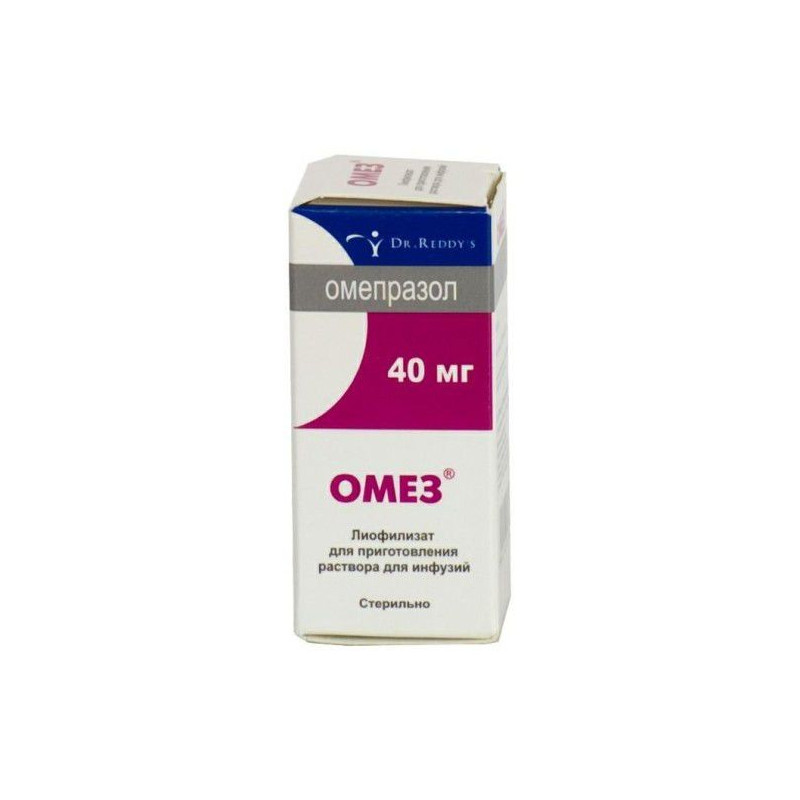



 All payments are encrypted via SSL
All payments are encrypted via SSL
 Full Refund if you haven't received your order
Full Refund if you haven't received your order
- peptic ulcer of the stomach and duodenum (including prevention of relapse);
- reflux esophagitis;
- hypersecretory conditions (Zollinger-Ellison syndrome, stressful ulcers of the gastrointestinal tract, polyendocrine adenomatosis, systemic mastocytosis);
- NSAID-gastropathy;
- prevention of aspiration of the acidic contents of the stomach into the respiratory tract during general anesthesia (Mendelssohn's syndrome).
At severe exacerbation of peptic ulcer, reflux esophagitis and NSAID gastropathy, to patients who are not shown oral administration of the drug, the recommended daily dose of Omez ® 40 mg for administration in the form of intravenous infusion.
At Zollinger-Ellison syndrome the drug is prescribed in the initial dose of 60 mg / day. The dose should be chosen individually, perhaps the appointment in higher doses (80-120 mg / day). If the daily dose is over 60 mg, it should be divided into 2-3 infusions during the day.
At Mendelssohn's syndrome the drug is prescribed overnight at a dose of 40 mg and at least 2 hours before anesthesia / surgery at a dose of 40 mg.
Have elderly patients No need to adjust the dose.
Terms of preparation of the infusion solution
Solution for IV injection is prepared immediately before use.For the preparation of the solution for IV injection should be used only 5% preservative-free dextrose (glucose) solution. To dissolve 40 mg of lyophilized powder of Omeprazole, at least 5 ml of solvent is added to the vial and gently shaken until the lyophilisate is completely dissolved. The prepared solution containing 40 mg of omeprazole, before administration, is diluted in 100 ml of 5% dextrose (glucose) solution without preservatives for intravenous infusion for at least 30 minutes. Prior to the introduction, you should ensure that there are no suspended particles in the solution. The chemical and physical stability of the prepared solution of omeprazole is observed for 6 hours after the dissolution of omeprazole in 5% dextrose (glucose) solution.
From the hemopoietic system: in some cases - leukopenia, thrombocytopenia, agranulocytosis, pancytopenia.
From the digestive system: diarrhea or constipation, abdominal pain, nausea, vomiting, flatulence; rarely - increased liver enzymes, taste disorders; in some cases - dry mouth, stomatitis, in patients with previous severe liver disease - hepatitis (including jaundice), impaired liver function.
From the side of the central nervous system: in patients with severe concomitant somatic diseases - dizziness, headache, agitation, depression; in patients with previous severe liver disease, encephalopathy.
From the musculoskeletal system: in some cases - arthralgia, myasthenia, myalgia.
Dermatological reactions: rarely, skin rash and / or itching; in some cases - photosensitization, erythema multiforme exudative, alopecia.
Allergic reactions: urticaria, angioedema, fever, bronchospasm, interstitial nephritis and anaphylactic shock.
Other: rarely - gynecomastia, malaise, visual disturbances, peripheral edema, increased sweating, the formation of gastric glandular cysts during long-term treatment (a consequence of inhibition of secretion of hydrochloric acid, is benign reversible).
- childhood;
- pregnancy;
- lactation period;
- Hypersensitivity to the drug.
WITH caution It should appoint a drug for renal and / or liver failure.
Use of Omez® during pregnancy and lactation (breastfeeding) is contraindicated.
WITH caution should be prescribed the drug for liver failure.
WITH caution It should appoint a drug for renal failure.
It is contraindicated in children.
Have elderly patients No need to adjust the dose.
Before starting therapy, it is necessary to exclude the presence of a malignant process (especially in case of a stomach ulcer), since treatment, masking the symptoms, may delay the correct diagnosis.
Influence on ability to drive motor transport and control mechanisms
During the period of treatment, care must be taken when driving vehicles and engaging in other potentially hazardous activities that require increased concentration and psychomotor reactions.
According to clinical studies with the on / in the introduction of omeprazole at a dose of up to 270 mg / day and at a dose of up to 650 mg for 3 days, no dose-related side effects have been identified.
Symptoms: confusion, blurred vision, drowsiness, dry mouth, headache, nausea, tachycardia, arrhythmia.
Treatment: symptomatic. Hemodialysis is not effective enough.
With the simultaneous use of Omez® may reduce the absorption of ampicillin esters, iron salts, itraconazole and Ketoconazole, since Omeprazole increases the pH of the stomach.
Being an inhibitor of cytochrome P450, omeprazole can increase the concentration and reduce the excretion of diazepam, indirect anticoagulants (warfarin), phenytoin (drugs metabolized in the liver with the participation of CYP2C19), which in some cases may require a reduction in doses of these medicines.
At the same time, long-term use of omeprazole in a dose of 20 mg 1 time / day in combination with caffeine, theophylline,piroxicam, Diclofenac, Naproxen, Metoprolol, propranolol, ethanol, cyclosporine, Lidocaine, quinidine and estradiol did not lead to a change in their concentration in plasma.
Plasma concentrations of omeprazole and Clarithromycin increase during joint oral administration of these drugs, while no evidence of interaction between omeprazole and Metronidazole and Amoxicillin has been found.
List B. The drug should be stored in a dry, dark place, out of reach of children at a temperature not exceeding 25 ° C.
